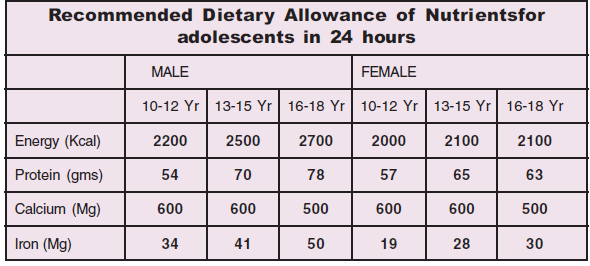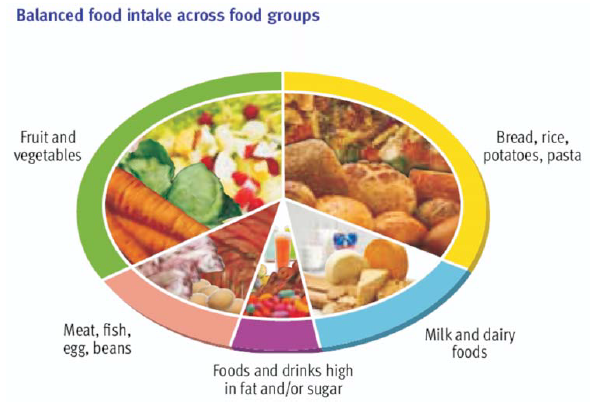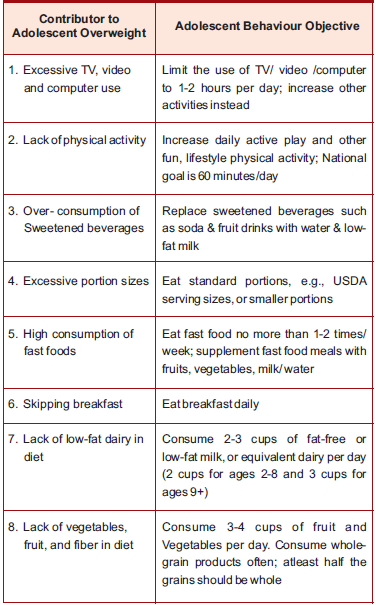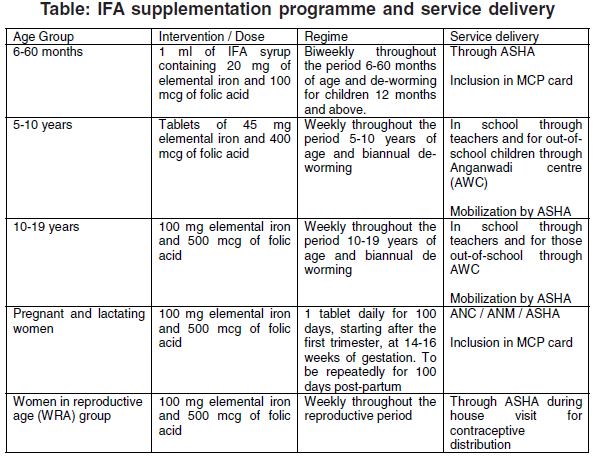Nutritional Needs of Adolescents
Nutritional Needs of Adolescents
Growth and Development in Adolescence
Adolescence is a significant period for physical growth and sexual maturation. Nutrition being an important determinant of physical growth of adolescents is an important area that needs attention. Growth retardation is one of the most important health concerns for adolescents and their parents as well as health care workers.
Inadequate nutritional intake during adolescence can have serious consequences throughout the reproductive years and beyond. Poor nutrition during adolescence can impair the work capacity and productivity of adolescent boys and girls in their later years. Further, an undernourished girl is at the risk of developing complications during pregnancy and the chances of her giving birth to a low birth weight baby increases, thus perpetuating a vicious cycle of malnutrition and ill-health.
Major components of food
Major components of food include protein, fats, carbohydrates, minerals and vitamins which perform different functions.
Function of various food components
- Proteins are of greatest importance in nutrition. Proteins are required for bodybuilding and help in repair and maintenance of body tissues.
- Fats are high-energy foods and a source of energy. They also make the food more palatable and provide fat-soluble vitamins.
- Carbohydrates form the major component of most diets and are the main source of energy.
- Vitamins and minerals are required in small quantities. They do not yield energy but enable the body to use other nutrients and also play in important role in growth, repair and regulation of vital body functions.
- Requirements for iron and calcium are particularly increased in adolescence, due to rapid physical growth during adolescence.
- Calcium needs during adolescence are greater than they are in either childhood or adulthood because of rapid increase in lean body mass and skeletal growth
- Zinc is especially important in adolescence because of its role in growth and sexual maturation. Some sources of zinc are grains, nuts, meat, cheese and milk.
A balanced diet is one that provides all nutrients (carbohydrates, proteins, fats, vitamins and minerals) in required amounts and proportions for maintaining health and general well being and also makes a small provision for extra nutrients to withstand short duration of leanness. It can be achieved through a blend of four basic food groups, i.e. carbohydrates, proteins, fats, vitamins and minerals. As these are present in different types of food items like dals, chapati or rice, green vegetables, easily available fruits and milk it is important to eat these food items in the right mix everyday.

Factors influencing nutrition of adolescents
- Lack of knowledge in the family and community about the importance of nutrition during adolescence
- Lack of food because of socio-economic circumstances
- Inequitable distribution of food in the family wherein girls being denied nutritious food
- Poor dietary intake of food and vegetables rich in iron
- Poor bioavailability of iron in the diet
- Hookworm infestation
- Diseases like Malaria
- Bad cooking habits (over boiling vegetables and straining water, removing husk from wheat, eating polished rice and straining rice water, etc.)
- Perpetuation of a vicious cycle of malnutrition and infection, which might begin, even before birth and may have more serious consequences for the girl child
Eating right and nutritious food during adolescence
- Food selection is based mainly on availability, convenience and time, rather than food value
- Influence of peers, mass media, prevalent body image
- Personal self-esteem and body image guide the eating behaviour
- Missing meals and snacking are very common
- Fast food joints are mainly patronized by adolescents. These spoil the appetite for regular meals and are high on calories and low on nutrients.
- Helps in achieving rapid growth and full growth potential
- Helps in timely sexual maturation
- Ensures adequate calcium deposition in the bones and helps in achieving normal bone strength
- Establishes good eating habits and sets the tone for a lifetime of healthy eating. This prevents obesity, osteoporosis (weak bones due to deficiency of calcium), and diabetes in later life.
Young girls who have inadequate nutrition do not grow well and become stunted women. Adolescent girls often suffer from anaemia because of poor consumption of iron rich foods and also due to worm infestation and frequent infections. Because of severe malnutrition and repeated illness, the growth spurt in early adolescence does not occur and a slower and prolonged pubertal growth period is seen in adolescents from lower socio-economic status. Hence, any damage to the body physiology during adolescence, which places extra nutritional demand on the body, like early pregnancy, is detrimental as growth this still to be attained. Adolescent mothers are more likely to deliver low birth babies. Due to poor milk production the infant may not be able to gain enough weight and remain malnourished. If these babies are girls, they are likely to continue the cycle by being stunted in adulthood, and so on, if something is not done to break this cycle. Support is needed for nutrition at all stages - infancy, childhood, adolescence and adulthood.
Balanced Diet
A young person should eat a diet balanced across the five food groups. They should eat:
- plenty of fruit and vegetables
- adequate quantities of rice and other cereals, potatoes, noodles and pasta
- some milk and dairy products such as yoghurt and cheese and
- some meat, fish, poultry, eggs and/or nuts and legumes.
- The relative proportion of the five groups is depicted in the diagram 1.
- In addition, they should:
- choose foods that are low in salt and
- limit foods that contain a lot of fat or sugar.

Definition of Overweight and Obesity
Overweight : A person may be overweight from extra muscle, bone, or water, as well as from having too much fat. Both terms mean that a person's weight is higher than what is thought to be healthy for his or her height.
Obesity : Obesity is a state in which there is a generalized accumulation of excess fat in adipose tissue in the body leading to more than 20% of desirable weight. Obesity has several adverse health effects and can even lead to premature death. Obesity leads to high blood cholesterol, high blood pressure, heart disease, diabetes, gallbladder stone and certain types of cancer.
Factors responsible for obesity
- Inactive life style
- Gene and family history
- Junk food and over eating
- Psychological
- Environmental causes
- Diseases
- Drugs
- Tobacco and alcohol
Health Promotion

Nutritional Anaemia
The need for iron increases with rapid growth and expansion of blood volume and muscle mass. As boys gain lean body mass at a faster rate than girls, they require more iron than girls. The onset of menstruation imposes additional needs for girls. Adolescents should be encouraged to consume iron rich foods (green leafy vegetables, jaggery, meat) complemented with a Vitamin C source like Citrus fruits (oranges, lemon) and Indian gooseberry (Amla). Adolescent girls need additional requirement of Iron to compensate for menstrual blood loss.
Iron deficiency in diet leads to nutritional anaemia.
What is anaemia?Our blood contains a red pigment called haemoglobin, which carries oxygen and is rich in iron. Anaemia is the loss of oxygen carrying capacity of the blood due to deficiency of haemoglobin in the red blood cells.
Iron deficiency anaemia is a major nutritional problem in adolescent boys and girls in India. The ill effects of anaemia can be seen as:
- Reduced capacity to work and thus decreased productivity
- Increased risk to pregnant girls/women. (In India, 20-40% of maternal deaths are due to anaemia).
- Anaemia may increase susceptibility to infections by impairing the immune functions.
Anaemia in Adolescents – causes, sign & symptoms, risk & key preventive measures
Main causes
- Inadequate iron intake/absorption/stores
- Frequent dieting or restricted eating
- Meal skipping
- Substance abuse
- Heavy/lengthy menstrual periods
- Rapid growth
- Adolescent Pregnancy
- Parasitic infection
Sign and symptom
- Fatigue, lethargy, dizziness, headaches
- Shortness of breath, ringing in ears, taste disturbances
- Restless leg syndrome
- Pallor, Flattened, brittle nails (spoon nail)
- Angular stomatitis (cracks at mouth corners)
- Glossitis, Blue sclera (whites of eyes), Pale conjunctivae
Key risks
- Impaired cognitive functioning and memory
- Decreased school performance
- Compromised growth and development
- Increased lead and cadmium absorption
- Increased risk of pregnancy complications,
- Including prematurity and fetal growth retardation
- Decreased work capacity
- Depressed immune function
How can anaemia be prevented?
- Anaemia can be managed through proper diet and iron supplementation. To prevent anaemia, increase the intake of green leafy vegetables and fruits. If an adolescent looks pale, fatigued or listless and anaemia is suspected, refer to the nearest PHC. Anaemia is treated by giving iron and folic acid tablets on a daily basis till 2-3 months after haemoglobin levels have returned to normal.
- Encourage adolescents, particularly those with risk factors for iron-deficiency anaemia, to follow the dietary strategies as discussed above.
- Adolescents who are at high risk for anaemia, such as female athletes with heavy menses, may benefit from routine or periodic use of a low dose iron supplement.
Other deficiency states
- Inadequate nutrition during adolescence can potentially retard growth so that the adolescent remains short and thin. The full height potential may not be reached and the adolescent may remain stunted. The sexual maturation may be delayed with late onset of puberty. Poor nutrition impairs work capacity and the boy/girl may feel tired all the time.
- Zinc deficient diet results in growth failure and delayed sexual maturation.
- Iodine deficiency leads to a much wider spectrum of disorders commencing with intrauterine life and extending through childhood to adulthood with serious health and social implications. Iodine deficiency disorders include mental deficiency imparied mental functions, neurological defects, increased stillbirths, and perinatal and infant mortality.

Sources :
Last Modified : 9/26/2024
